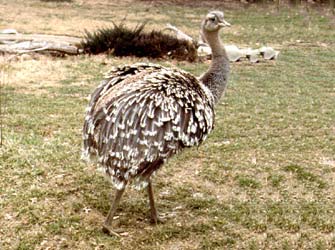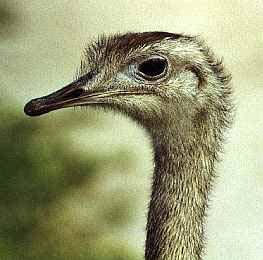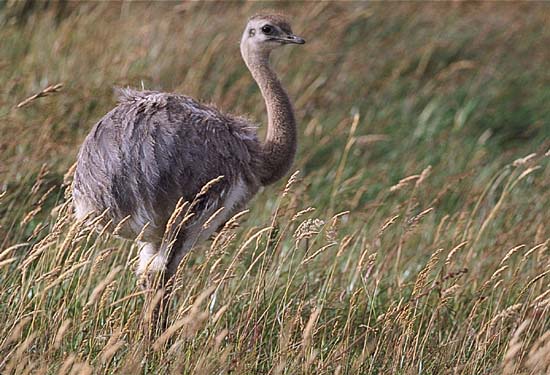Pterocnemia pennata (Lesser Rhea)
 Adult
Adult
Description: Huge, flightless, three-toed terrestrial birds with long necks and legs. The feathers cover the thighs and the top of the tarsi, only at the front. They are basically sandy brown with white spots on the tips of the feathers on the body and tail. The wings are hidden within the flank feathers.
The feathers are smooth and soft as they lack the interlocking hooks on the barbules that most birds have.
Females are generally duller than males with less white spotting. The eyes are brown and the legs and beak are greyish brown.
Size: 92.5-100 cm.
Weight: 15-25 kg.
Senses: Their eyesight and hearing is good, they can swim surprizingly well, being capable of crossing rivers. They can reach speeds of 60 km/h. They are qicker than the Greater Rheas but have less stamina.
Habitat: N races are found in desertic salt puna, pumice flats, upland bogs and tola heath, at about 3500-4500 m. Southern races occupy shrub-steppe and grassland of flood-plains, from sea-level up to 2000m.
They normally breed in upland areas with bunch-grass. Breeding areas tend to be close to a river, although their habitat can be fairly arid.
Range: They remain in a specific area throughout the year, moving upland to breed but not travelling to seek food and water. Males become territorial during the breeding season, females form small groups at this time but are not territorial, males are solitary and defend an area for nesting at this time. Males will threaten intruders and intertwine necks with them whilst running around in circles together, when the winner is decided he chases the loser from his range, sometimes they kick and bite one another as they compete.
Distribution: South America.
 Adult
Adult
Status: Not globally threatened. Has declined markedly and is now considered near-threatened. The nominate race is still fairly common, perhaps due to the inaccessibility and bleak conditions which prevail over much of their range, though their upland breeding habits may be the result of agricultural developement and hunting. In 1936 they where introduced to norhtern Tierra del Fuego, where they are now well established.
Daily Rhythm: They are basically diurnal, although they may rest through very hot periods and do their foraging during the night.
When they sleep they rest on the tarsi in a sitting position, the neck lyes stretched out horizontally in front or folded back to one side in an s-curve, and sometimes they may lie flat on their bellies and stretch their legs out behind.
Voice: The most common sound made is a deep, resounding "bu-up" or "nan-du", which is mainly produced by males during the courtship display. It can also occasionally be heard at night. The sound is more like the roar of a large mammal than the call of a bird and can be heard at great distances.
Outside the mating period they utter hoarse cries of alarm, snorts of anger and hisses as threats. Young birds produce plaintive contact whistles, which help them to keep together in their groups, especially when danger threatens.
Enemies: Although they are quite capable of outrunning their predators, they have a strange habit of retracing their steps and suddenly squatting down amongst the bushes and flattening their body against the ground. When they are lying flat against the ground they are often overlooked due to their cryptic plumage and despite their size. Another method they adopt for shaking off predators is a zig-zag run, as they flee they frequently dodge from side to side. They hardly ever hold their heads up as they run and hold it stretched out horizontally before them and hold their wings close to their bodies to make their dash through thick vegetation easier.
Prey: Omniverous. Taking mostly plant matter, including seeds and grasses, they also take small animals, especailly insects.
Food and Feeding: When feeding they normally walk slowly along with the head held low, picking food off the ground. They often join herds of llamas, guanacos or vicnas.
Generally they drink little water as most of their liquid comes from their succulent plant intake. They ingest pebbles and small shiny objects to help grind food in their gizzard.
Grouping: They are gregarious and live in mixed grouos with males, females and juveniles. Flocks normally number 2-30 individuals, though groups with 50 or more have been recorded. During the breeding season this grouping behaviour changes, females break up into small groups and males become solitary and territorial. Some older males become solitary throughout the year.
While they are sociable birds the individuals in the group keep a certain distance appart at all times. If another bird enters anothers persomnal space a threat will be issued. This consists of the bird throwing its head forwards with the bill open, at the same time they hiss repeatedly. The head is then repidly flung back so that the neck adopts and s-shape. Birds frequently perform this threat to intruders when they are incubating or simply sitting at rest.
Breeding: September-January in the north, starts in July in Rio Negro (Argentina) and November in extreme south.
Malesa re simultaneously polygynous and femalesa re serially polyandrous.
Males begin to occupy territories that they defend from intruders by means of short fights. They intertwine their necks and run around together in a circle, sometimes fights end with the birds kicking and biting each other and the male that wins the contest expels the other from his territory by means of a short chase. The winner will try to attract a group of females to his territory by running quickly towards them with his wings outspread. When he has assembled between 2-12 females he will proceed with his courtship display. In this he zig-zags around the females giving the characteristic booming sound, his neck is erect and inflated, his wings lifted up. Finally he stands beside the females with his neck slightly lowered in a u-shape, the feathers of his neck and head are bristled up, he shakes his wings and then stretches them out to the sides where he holds them motionless and quivering in the slightest breed.
After copulation the male leads the females to the nest he has prepared. The females generally approach the nest as a group, one after the other they lay their eggs in the hollow, after doing so their leave the nest site as a group and return every 2-3 days over the following weeks to lay the rest of their clutch.
Once the females have laid all their eggs in a particular nest they leave to mate with another male and to lay eggs in his nest. They may repeat this process several times during the 3 month breeding period.
When the male begins incubation, just 2-8 days after the first eggs have been laid, the male will not allow anyone close to the nest, he hisses and snaps, performing a display where he throws his head forward and spreads his wings to cover the eggs. He will even threaten the females that return to lay more eggs in his nest and the females are forced to lay their eggs around the nest. The eggs that are within reach of the sitting male are rolled into the nest by his bill, the other eggs are left scattered around the nest and rot, attracting flies that the male eats whilst sitting. Newly hatched chicks can also get their first meal from this source.
Gestation: The male begins incubation about 2-8 days after the egg laying has begun, and the incubation usually lasts about 40 days.
Litter Size: When all the females have finnished laying the nest contains between 10-30 eggs, although there have been cases with 6 and 50 eggs in one nest.
Young Description: Eggs are yellowish olive-green when they are laid but fade to buff, they are about 127 x 87 mm.
The chicks are greyish brown with blackish stripes and a fully feathered tarsi.
Juveniles are browner than adults and lack the white spotting, typical adult plumage is gained gradually and is complete during their 3-4 year.
 Juvenile
Juvenile
Nest: The nest is a scrape lined with dry grass or twigs. Usually the nest is built in cover of bushes, the male sometimes plucks up this vegetation within a radius of 2-3 m to protect it from fire.
Young Care: The male is left to incubate and care for the young alone. Once the first chicks are ready to hatch they begin to call, this is thought to stimulate the other chicks into breaking their shells, so all the chicks hatch within a period of 24-28 hours.
After a few days the chicks are lead from the nest by their parent, they keep together by means of a contact call, this is essential, for once they separated from their parent they are likely to fall easy prey to a number of predators. When danger does threaten the chicks, they crouch down on the ground or hide under the males wings, where they also take refuge from heat and cold.
Males are jelous guardians of their chicks, and when they encounter lost chicks they will adopt them, this sometimes gives the creche a range of ages.
The male takes care of the young for 6 months, but the young birds, that are now about half the size of the adult, generally reamin in a group until they become sexually mature.
Sexual Maturity: 3 years.
Longevity:
Geographical Variations:
Pterocnemia pennata garleppi
Distribution: South Peru, South West Bolivia, North West Argentina.
Description: Greyer, with fewer white spots.
Pterocnemia pennata tarapacensis
Distribution: North Chile.
Description: Greyer, with fewer white spots.
Pterocnemia pennata pennata
Distribution: South Chile, West Central and South Argentina.
Also introduced to Tierra del Fuego.
Back to Main Page
Back to Birds